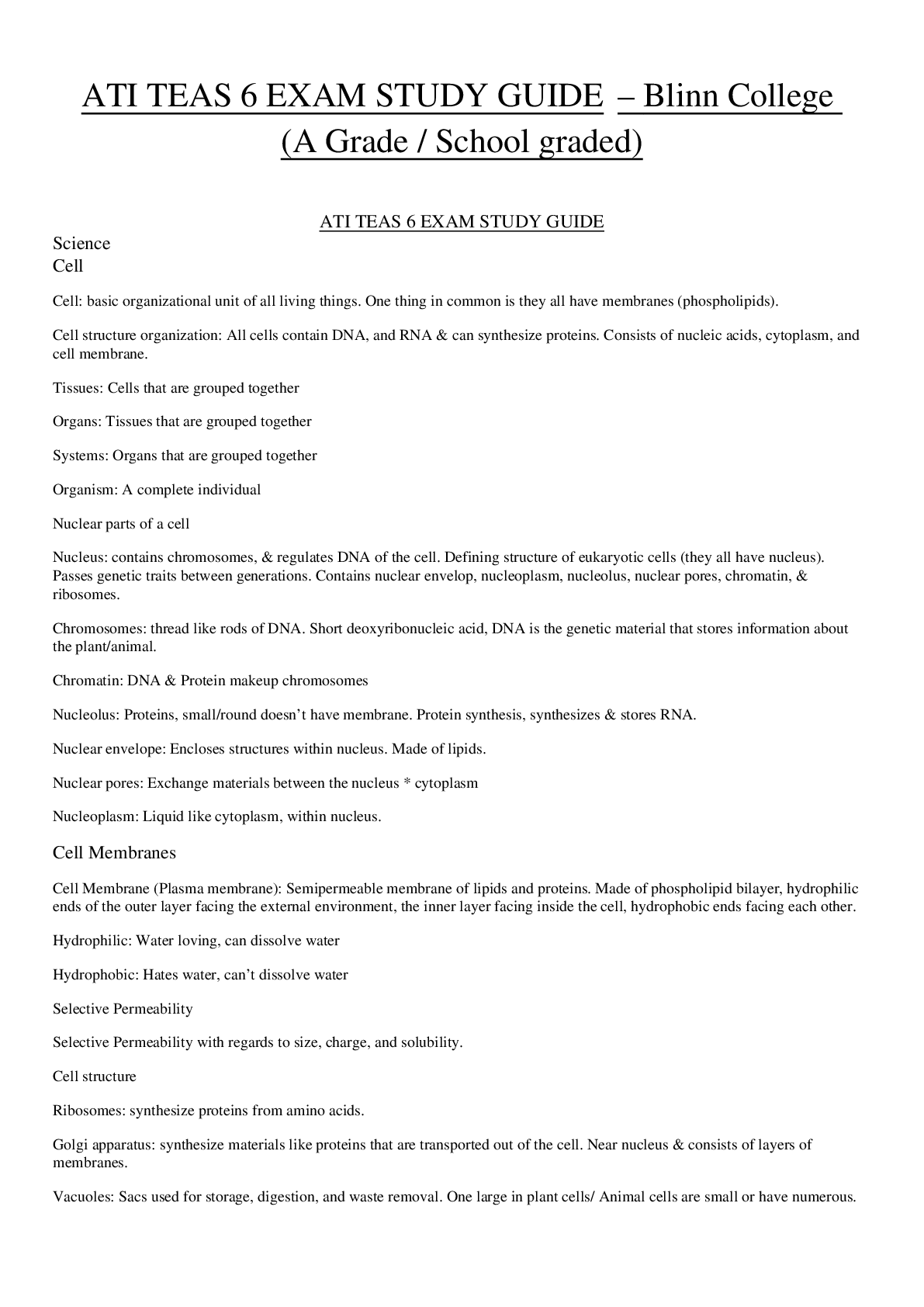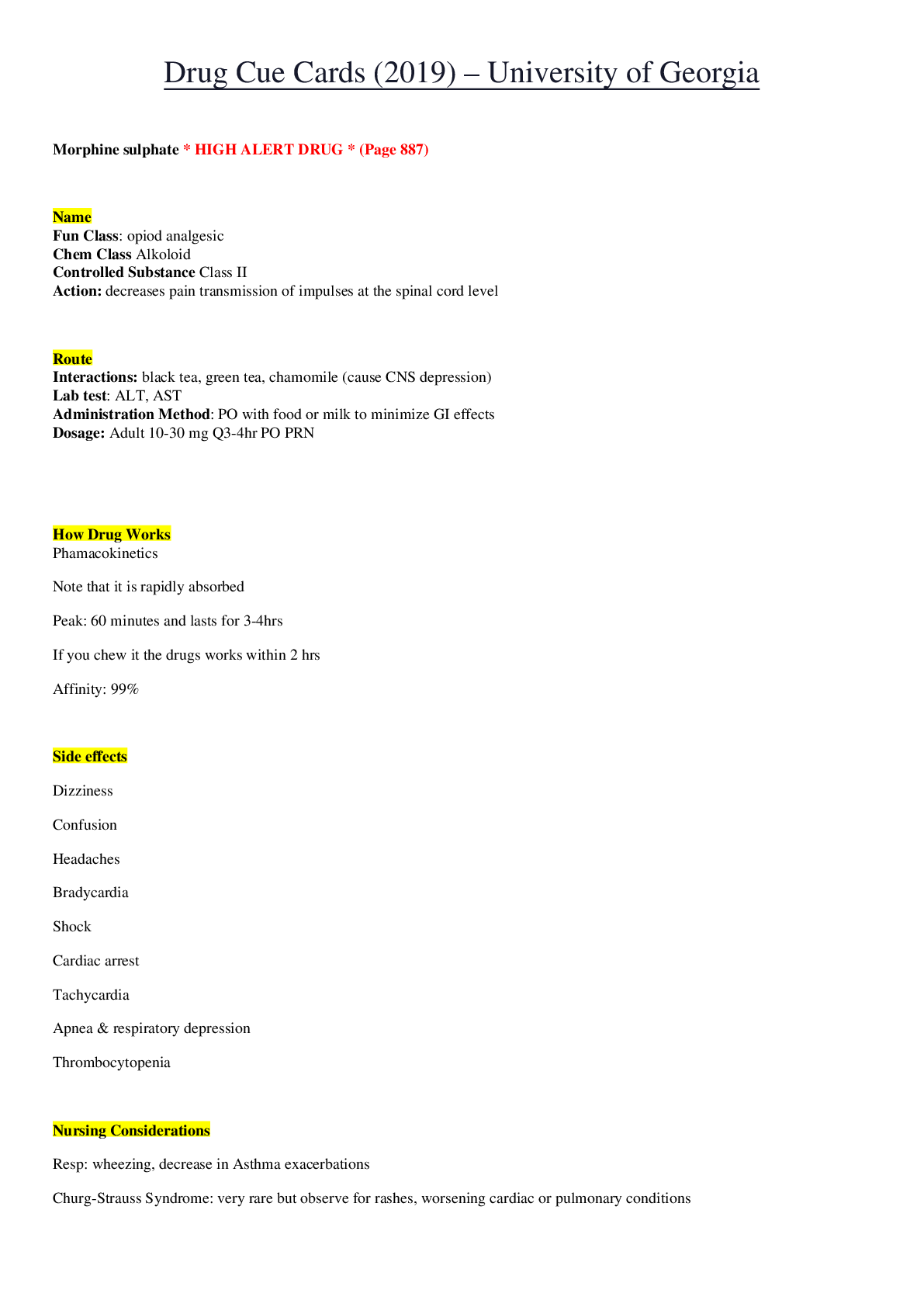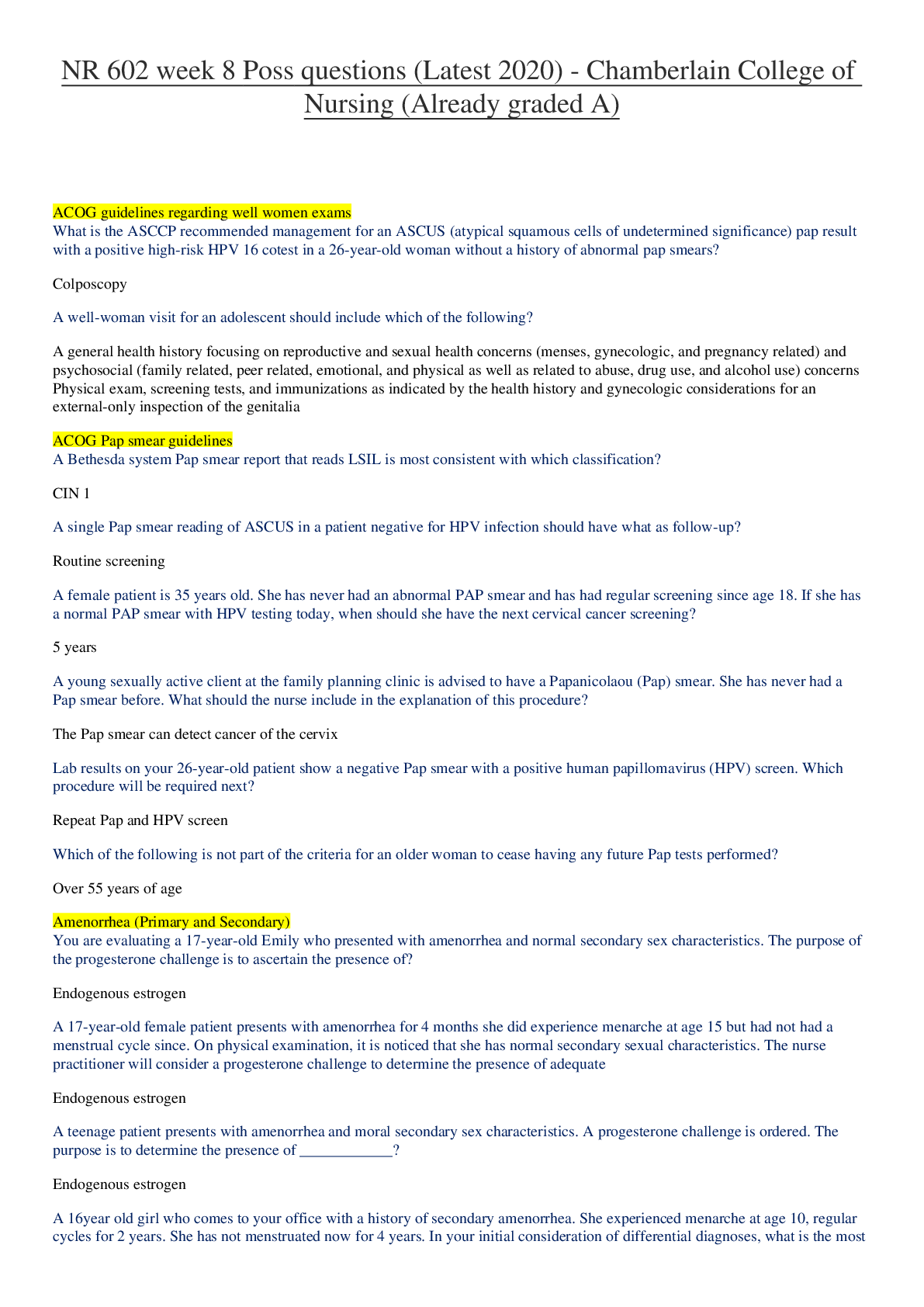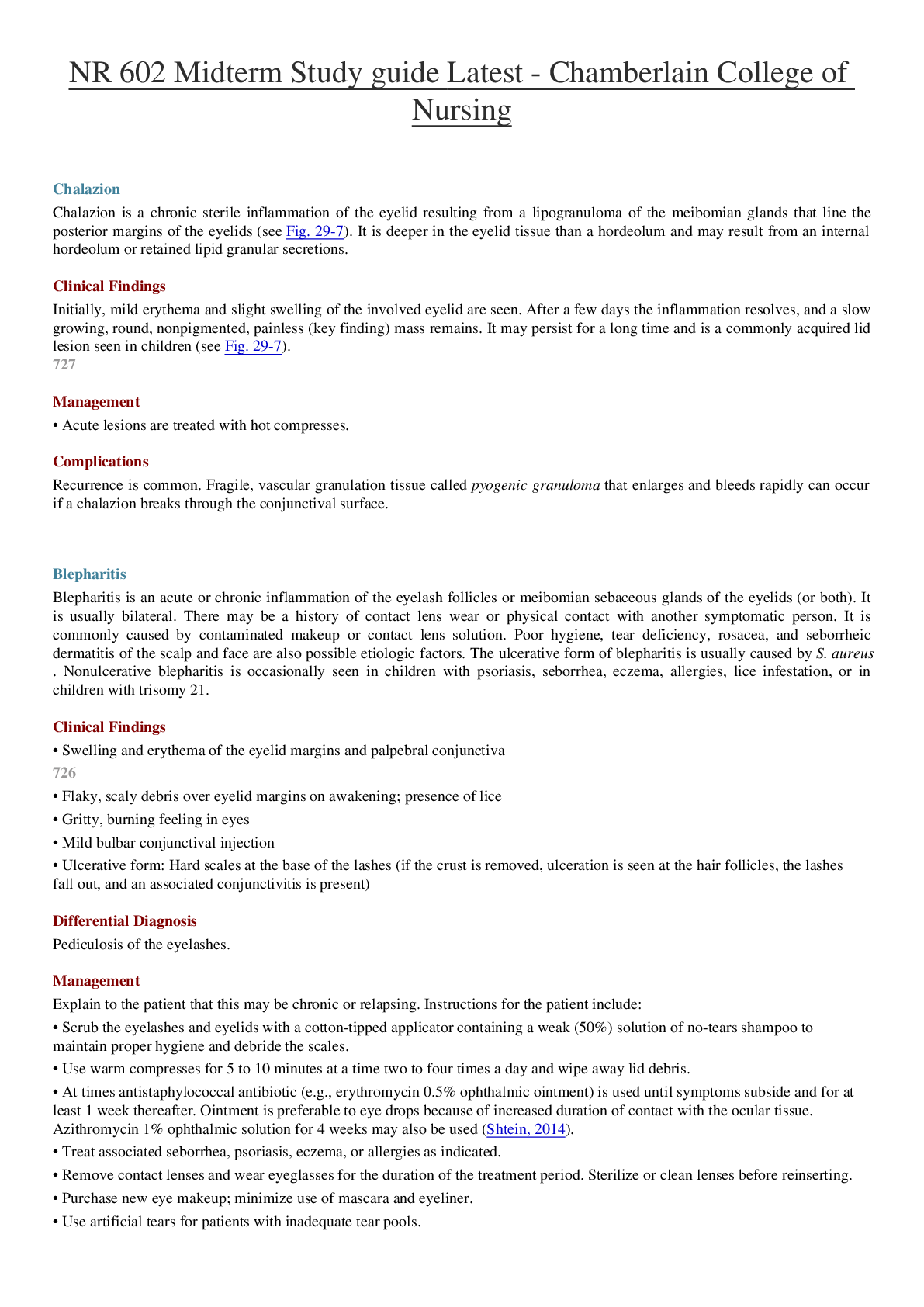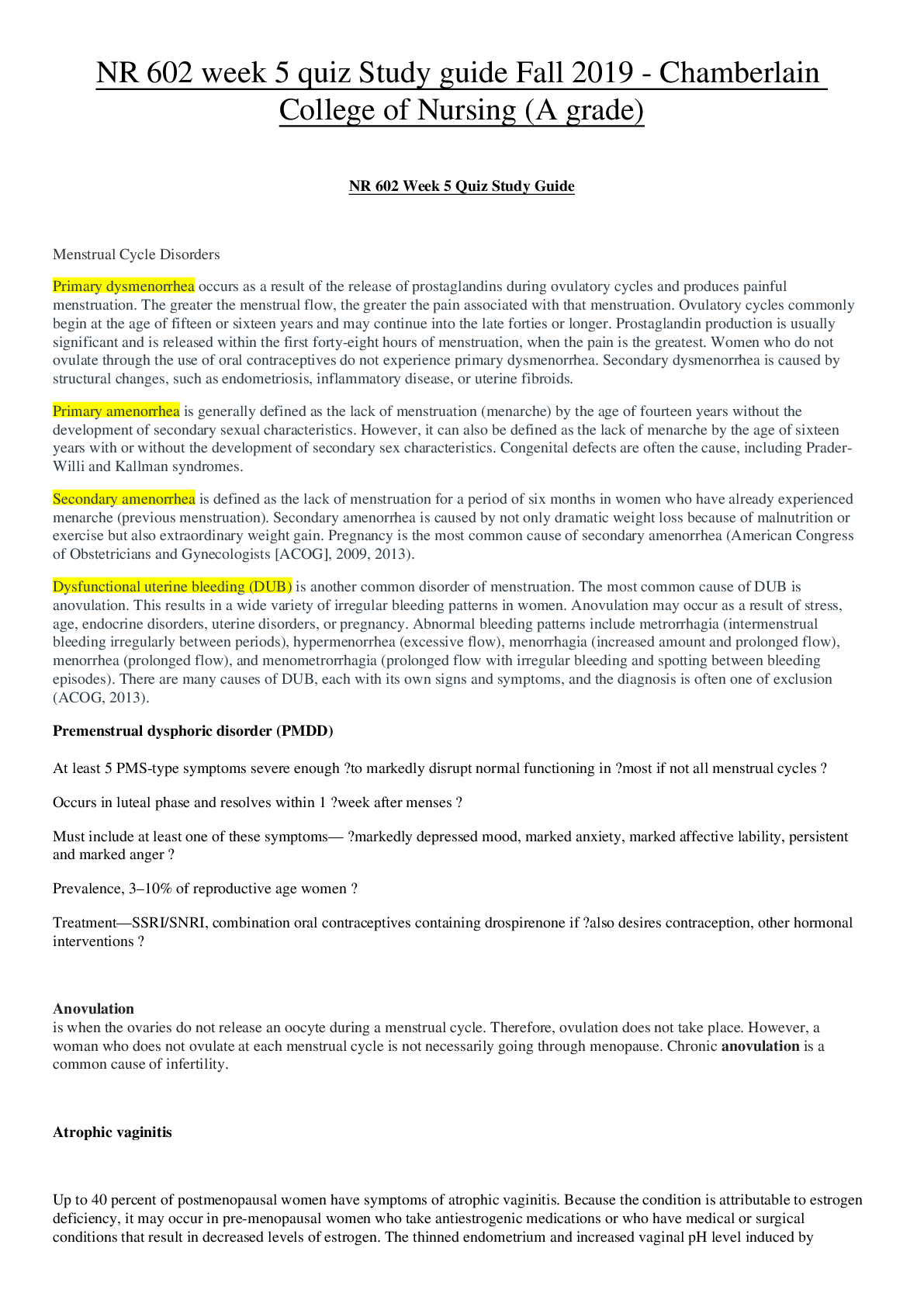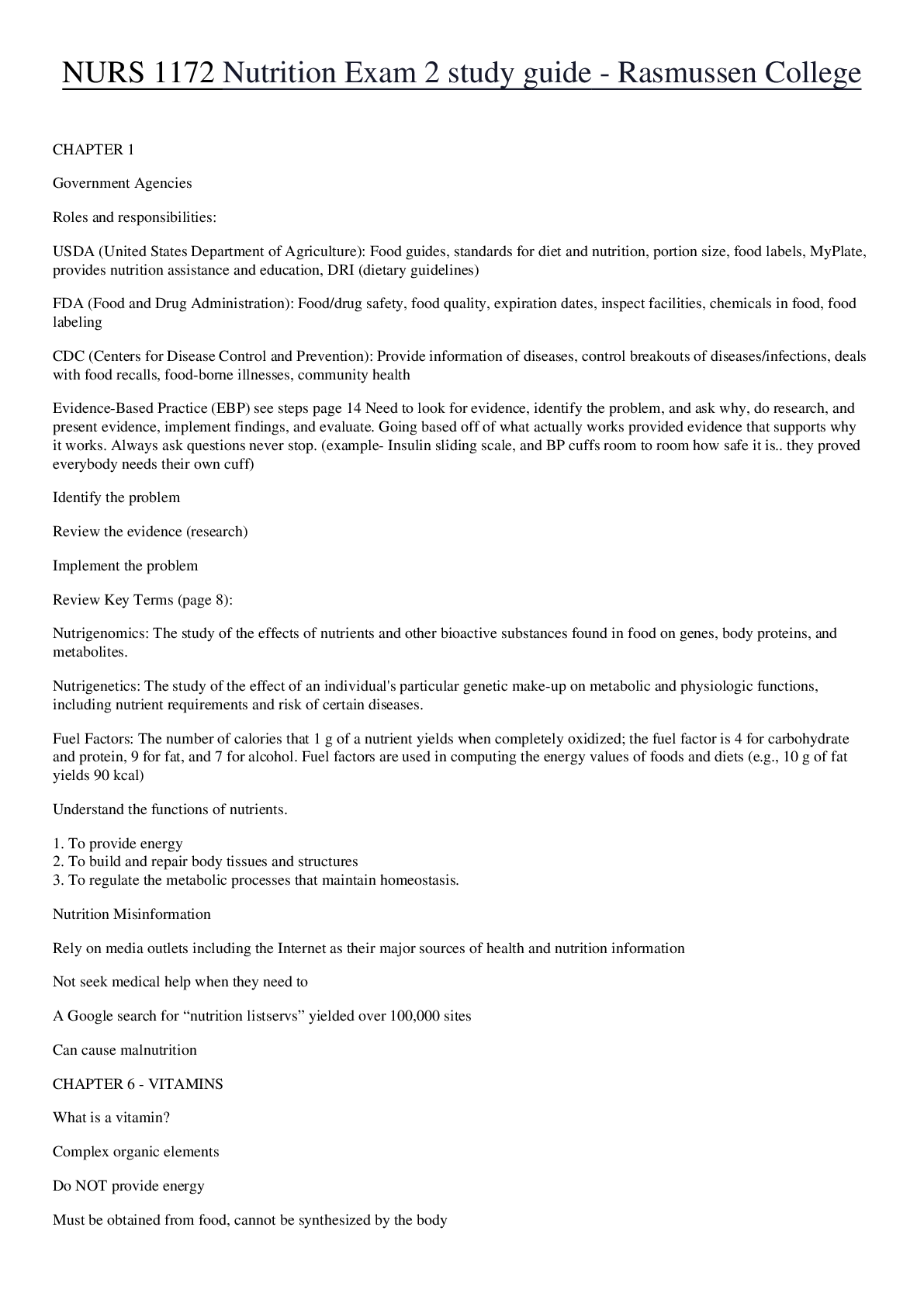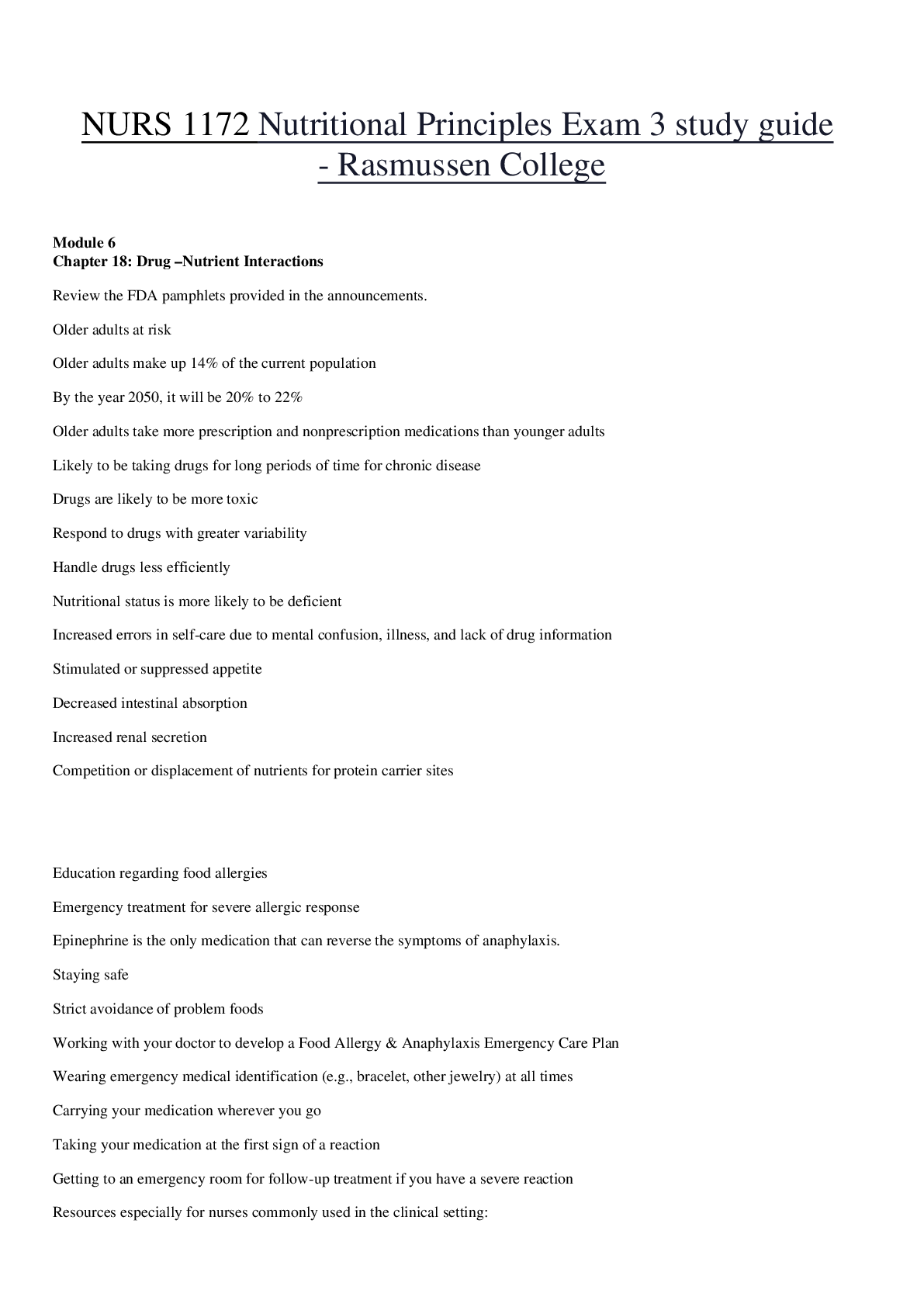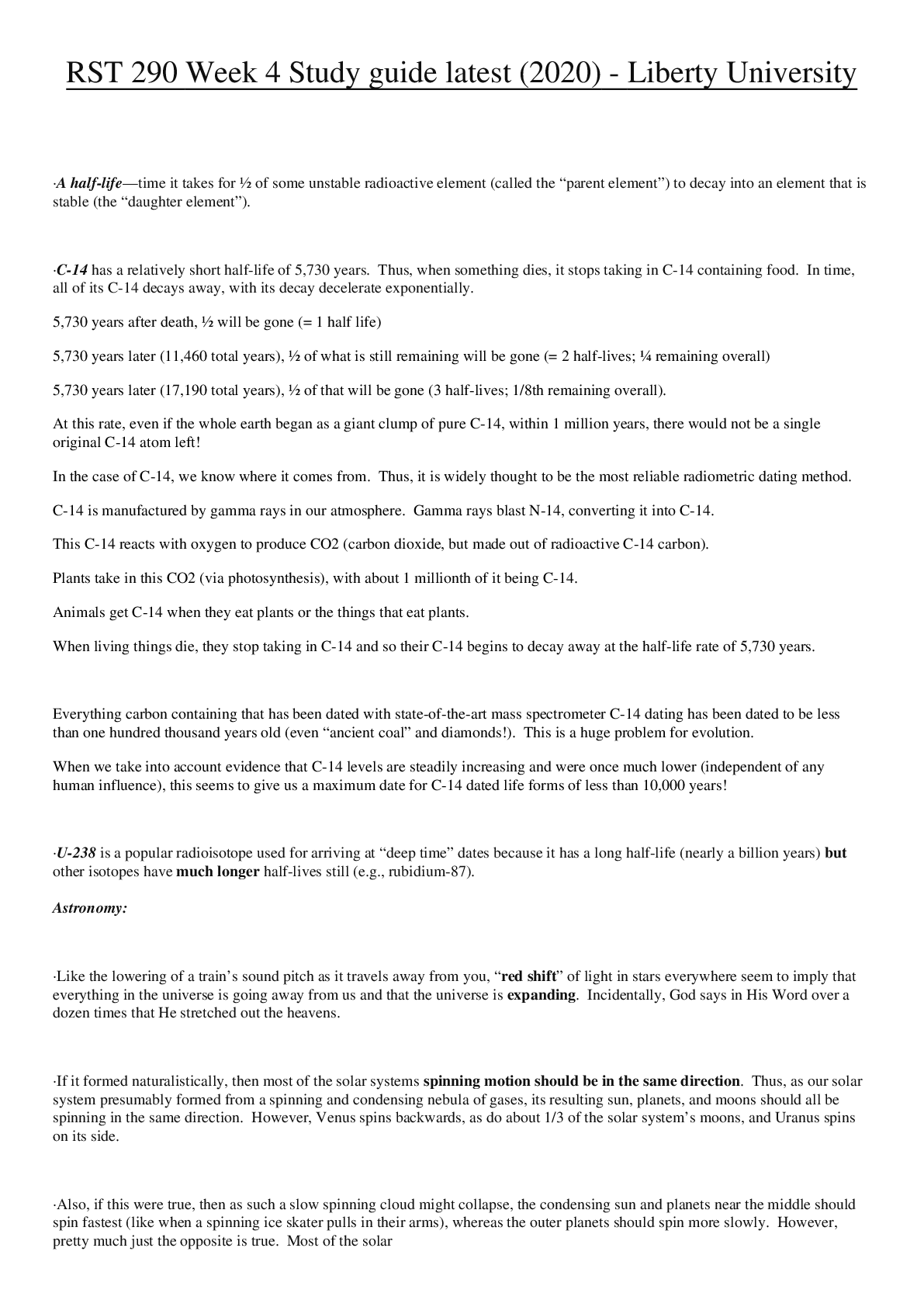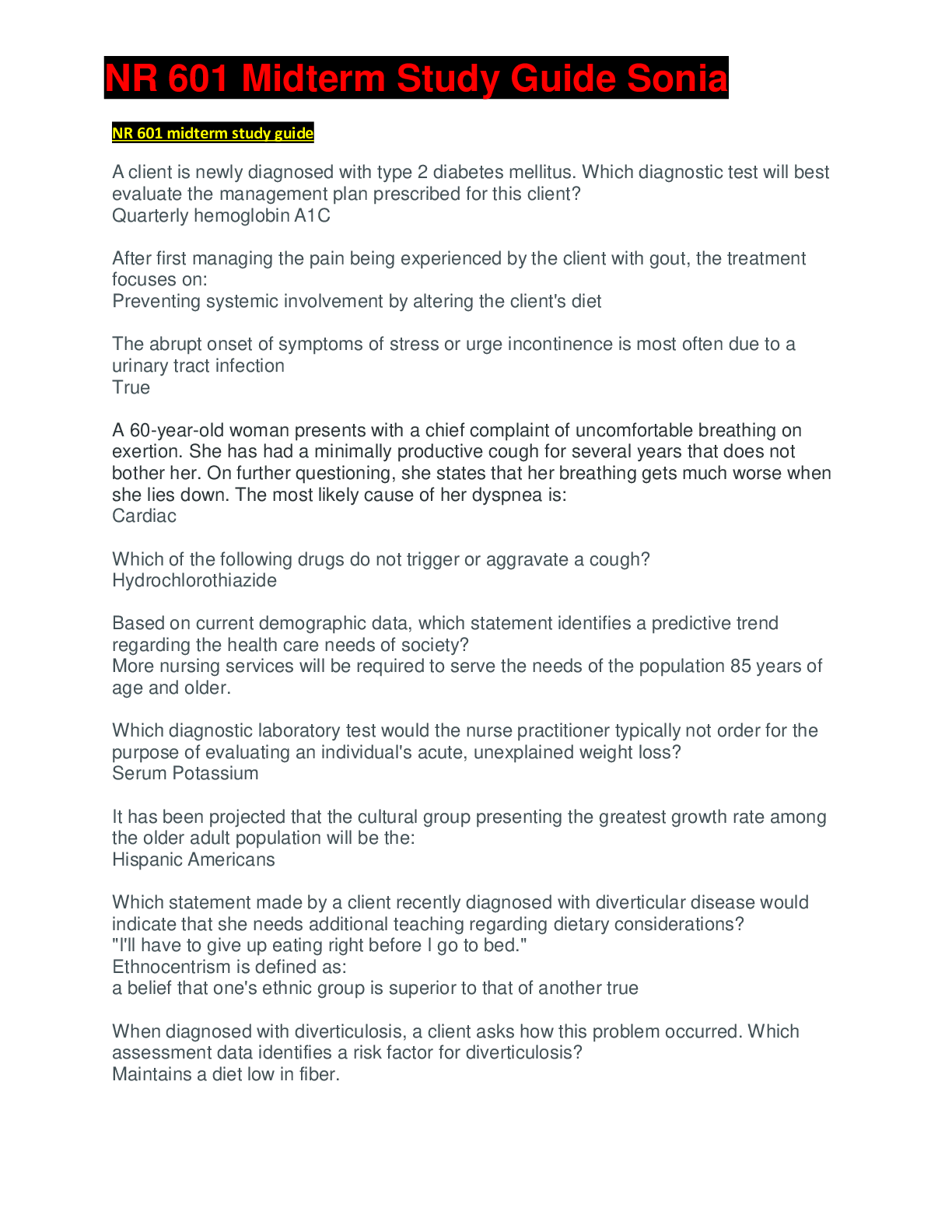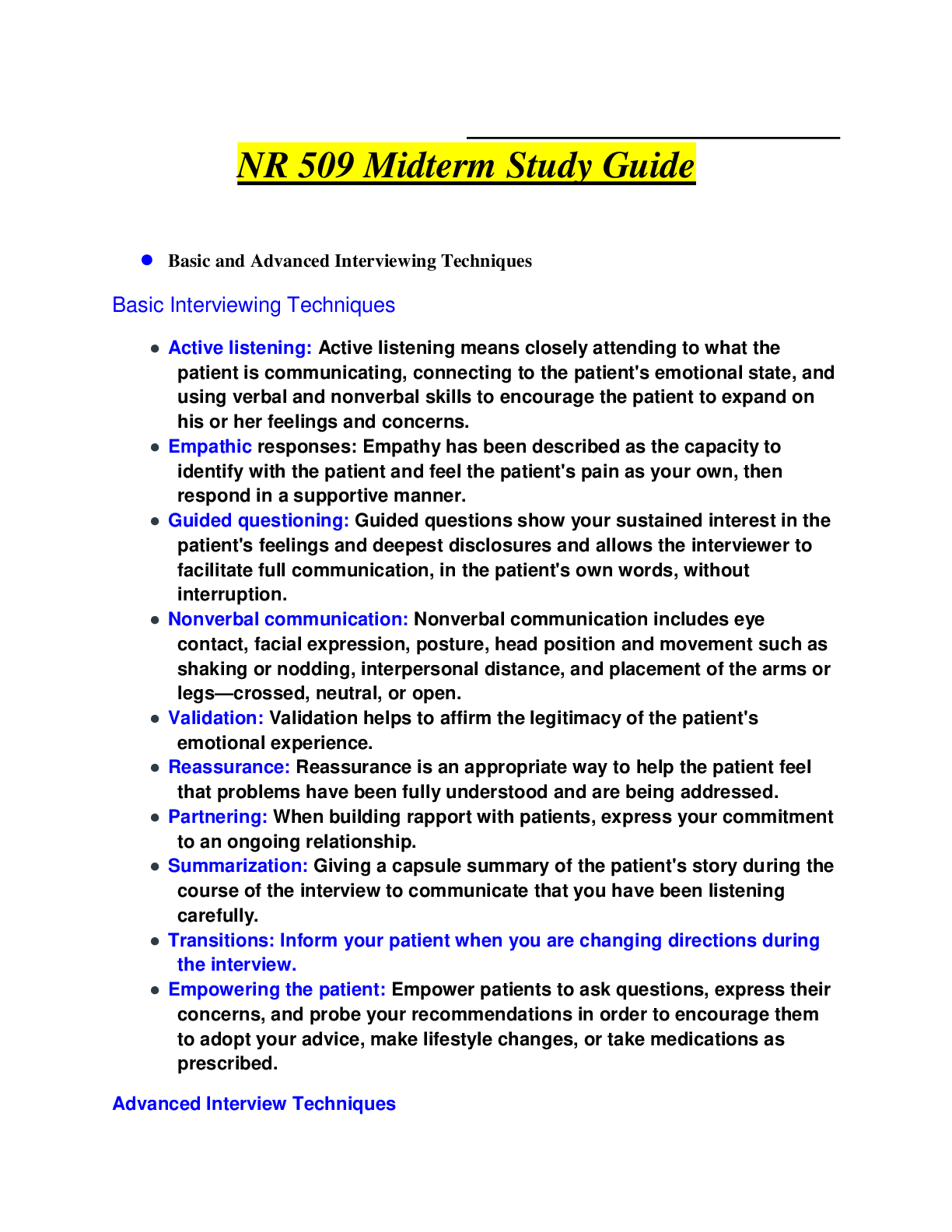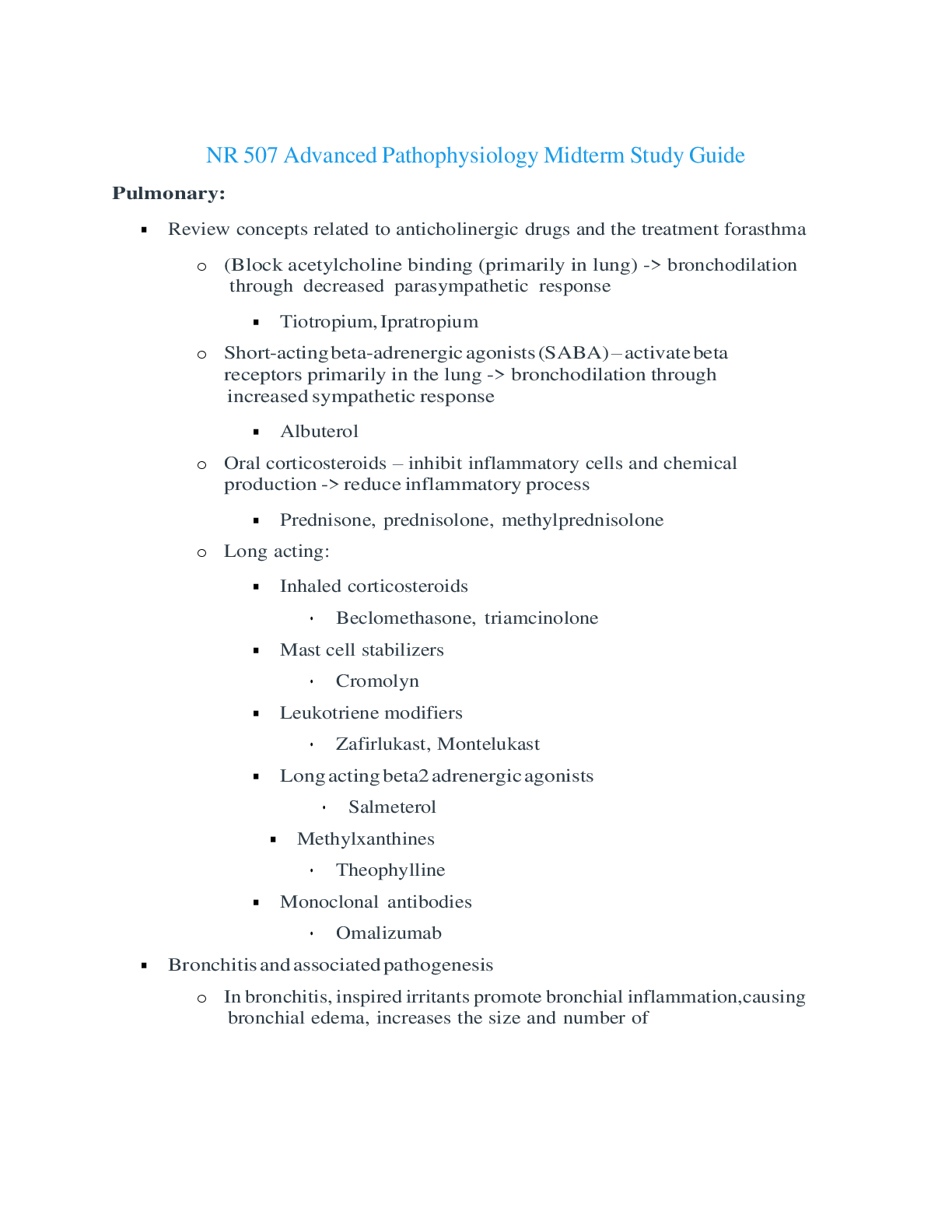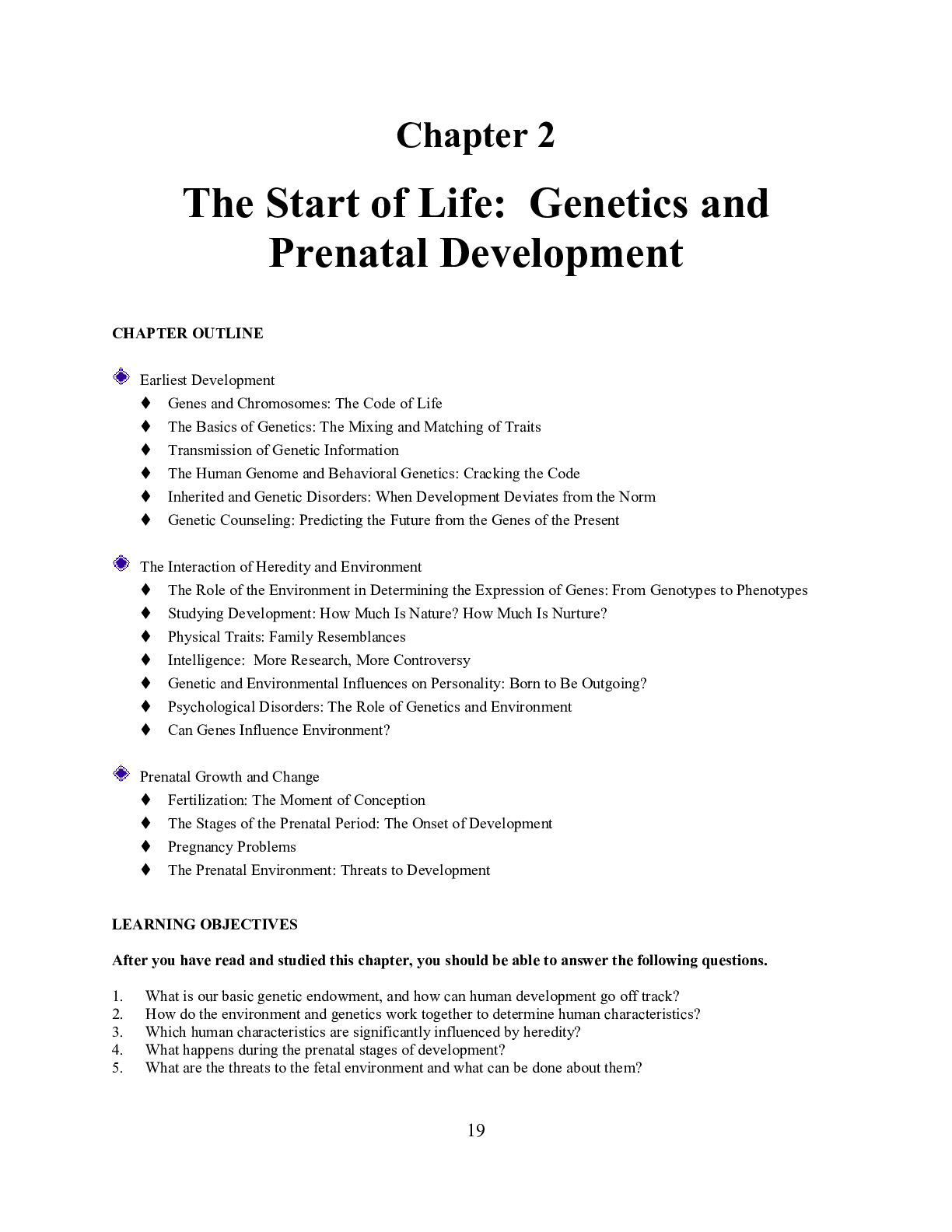*NURSING > STUDY GUIDE > NURS 6551 Midterm Study Guide latest (2020) – Walden University / NURS 6551 Midterm Study Guide la (All)
NURS 6551 Midterm Study Guide latest (2020) – Walden University / NURS 6551 Midterm Study Guide latest (2020)
Document Content and Description Below
NURS 6551 Midterm Study Guide latest (2020) – Walden University 6551 Midterm Study Guide #1 Alcohol Abuse Among Women • The USPSTF (2014a) assigns a “B” recommendation to screening all ... adults age 18 and older (including pregnant women) for alcohol misuse; screening adolescents younger than age 18 has been assigned an “I statement”. • Most of all recent research regarding effects of alcohol has been conducted on males • Smaller amounts of alcohol is associated with more severe damage to a women • Alcohol consumption is considered hazardous for a women who has either more than seven drinks per week or more than three drinks per day. • Women who consume more than seven drinks per day are considered at risk for developing AUD • Alcohol misuse screening tools include the AUDIT or Abbreviated AUDIT-C instrument or asking single questions. • Ask patient, how many times in the past year have you had four or more drinks in a day? #2 Feminist Perspective • Feminist is a model of care that works with women as opposed to for women. • Uses heterogeneity as an assumption, not homogeneity. • Minimizes or exposes power imbalance. • Rejects androcentric models as normative • Challenges the medicalization and pathologizing of normal physiologic processes. • Seeks social and political change to address women’s health issues. • A feminist model supports egalitarian relationships and identifies the women as the expert on her own body. • The women is the center of this healthcare model • Acknowledges the broader context in which women live their lives and the subsequent challenges to their health as a result of living within a patriarchal society. #3 Cultural Perspectives of Women • Adolescents- Using a relational approach when providing care to adolescent females, which is how adolescent females often define themselves. By asking questions such as “Tell me about your friends or who you hang out with”. • Early adulthood- Women at this age are facing childbirth and contraceptive issues, intimate partner violence, substance abuse and stress. • Midlife- Clinicians providing care for women in midlife need to promote healthy sexual functioning and assess changes that may negatively impact desire. • Older women- Some women become isolated. Elderly women contend with ageism and sexism. • Problems faced by Mexican and Central American women include feeding their families, accessing formal health care. • Undocumented migrant women also face problems with obtaining assistance with food and health care due to the inability to seek assistance • Veterans have increased risk for having been sexually assaulted, have post-traumatic stress disorder and traumatic brain injury • People who are assigned female sex at birth are natal females, those who are assigned as males are considered natal males. • Transgender woman is a natal male who has a female gender identity. • A transgender man is a natal female who has a male gender identity • Cisgender refers to someone whose gender identity matches their natal sex • LBQ women and TGNC (Transgender and gender non-confirming) experience interpersonal and institutional discrimination. • LBQ and TGNC people face rejection of their families, their communities and spiritual levels. • LBQ and TGNC face the risk of not being involved with their partners in times of health crises, or able to participate in medical decisions of their partners when incapacitated. • LBQ and TGNC people are less likely to have insurance or be able to afford healthcare. • TGNC persons are at higher risk for suicide and are 5 times at greater risk for depression • Clinicians must create environments that are welcoming and nonthreatening to patients of all gender identities and sexual orientations • EMR must be able to identify the patient with their physical sex as well as their identified sex • Use open-ended and gender-neutral language • Examinations must be based on anatomy and organs present, not the perceived gender of the patient • For Transgender men taking testosterone- provide a short course of vaginal estradiol prior to vaginal examinations, as well as topical anesthetic to reduce pain. • LBQ and TGNC youth are at an increased risk for violence, homelessness and substance abuse than others of their age. • Older adults of the LBQ and TGNC population are particularly vulnerable to abuse, neglect and poverty. • Some religions and restrictive family upbringings may alter a woman’s ideas about sexuality and their ability to enjoy their sexuality. • Black women experience menopause earlier than other women, an average age of approximately 50 years. • Caucasian and hispanic women have reported greatest number of psychosomatic symptoms of menopause (moodiness, headaches, palpitations), • African American women reported highest severity of vasomotor symptoms of menopause • Asian women reported problems with joint pain and stiffness, especially in the neck, shoulders and back. • Women who are migrant workers may not report IPV for fear of deportation. • Migrant workers commonly have the belief that the woman is subordinate to the man and not be aware of support services • Domestic Violence is the leading cause of homicide in women globally • Contraceptive considerations for couples that are part of cultural groups that prohibit contraceptives: a. A. Cervical mucus monitoring b. B. Basal body temperature monitoring c. C. Menstrual cycle charting d. D. Ovulation sensations e. E. Electronic hormonal fertility monitoring • Native American women have the highest rates of rape and assault in the U.S. (Leik) • Muslim women may refuse to undress and cannot be examined by a male practitioner without her husband or another male of her family present. #4 Tanner Stages • A commonly used scale for assessing sexual maturity and pubertal development is the Tanner scale, which for girls, relies on development of the breast and growth of pubic hair. It divides sexual physical maturity into five stages that extend from preadolescence to adulthood. o Tanner Stage 1 (Prepubertal) Breast • Papilla elevation only Pubic Hair • Villus hair only • No coarse, pigmented hair o Tanner Stage 2 Breast • Breast buds palpable and areolae enlarge Pubic Hair • Minimal coarse, pigmented hair mainly on labia o Tanner Stage 3 Breast • Elevation of Breast contour; areolae enlarge Pubic Hair • Dark, coarse, curly hair spreads over mons pubis Other changes • Axillary hair develops • Acne Vulgaris develops o Tanner Stage 4: Breast • Areolae forms secondary mound on the Breast Pubic Hair • Hair of adult quality • No spread to junction of medial thigh with perineum o Tanner Stage 5: Breast • Adult breast contour • Areola recesses to general contour of breast Pubic Hair • Adult distribution of hair • Pubic hair spreads to medial thigh • Pubic hair does not extend up linea alba #5 Primary prevention versus secondary prevention • Primary Prevention: These services focus on preventing disease in susceptible populations. Examples of primary preventive efforts include health education and counseling, and targeted immunizations. • Secondary Prevention: These services focus on early detection of disease states and subsequent prompt treatment that will reduce the severity and limit the short- and long-term sequelae of the disease. Routine laboratory screening is an example of secondary prevention. • Tertiary Prevention: These services limit disability and promote rehabilitation form clinical disease states. #6 The US Preventative Services Task Force (USPSTF) recommendations: Mammography: • Age: All women Recommendation: The USPSTF recommends against teaching breast self-examination (BSE). • Age: 40 Years and Older Recommendation: The USPSTF concludes that the current evidence is insufficient to assess the additional benefits and harms of clinical breast examination (CBE) beyond screening mammography in women 40 years or older. • Age: Women, Before the Age of 50 Years Recommendation: The decision to start regular, biennial screening mammography before the age of 50 years should be an individual one and take patient context into account, including the patient's values regarding specific benefits and harms. • Age: Women, Age 50-74 Years Recommendation: The USPSTF recommends biennial screening mammography for women 50-74 years. • Age: Women, 75 Years and Older Recommendation: The USPSTF concludes that the current evidence is insufficient to assess the benefits and harms of screening mammography in women 75 years and older. Cervical Cancer Screening: • Age: Women younger than 21 o Recommendation: The USPSTF recommends against screening for cervical cancer in women younger than age 21 years. • Age: Women 21 to 65 (Pap Smear) or 30-65 (in combo with HPV testing) o Recommendation: The USPSTF recommends screening for cervical cancer in women age 21 to 65 years with cytology (Pap smear) every 3 years or, for women age 30 to 65 years who want to lengthen the screening interval, screening with a combination of cytology and human papillomavirus (HPV) testing every 5 years • Age: Women younger than 30 years, HPV testing o Recommendation: The USPSTF recommends against screening for cervical cancer with HPV testing, alone or in combination with cytology, in women younger than age 30 years. • Age: Women Older than 65, who have had adequate prior screening o Recommendation: The USPSTF recommends against screening for cervical cancer in women older than age 65 years who have had adequate prior screening and are not otherwise at high risk for cervical cancer. • Age: Women who have had a hysterectomy o Recommendation: The USPSTF recommends against screening for cervical cancer in women who have had a hysterectomy with removal of the cervix and who do not have a history of a high-grade precancerous lesion (cervical intraepithelial neoplasia [CIN] grade 2 or 3) or cervical cancer. Chlamydia and Gonorrhea: Screening • Age: Sexually Active Women o Recommendation: The USPSTF recommends screening for chlamydia and gonorrhea in sexually active women age 24 years and younger and in older women who are at increased risk for infection. #7 Preventable causes of death *Cardiovascular disease is the leading causes of death in females. (CDC, 2015). Preventable causes of death for women are related to: Modifiable, behavioral risk factors: 1. Tobacco use with related illnesses (Lung Cancer) • Leading preventable cause of death • Risk of MI, CVA, lung cancer (and others) 2. Overweight or Obesity 1. Morbidity and mortality Elevated Low-Density lipoprotein (LDL) cholesterol levels Diabetes 2. CAD, CVA, DM, Kidney Disease, Respiratory problems 3. Risk of premature death 4. Disability 3. Poor diet 4. Physical inactivity USPSTF recommendations: 1. Overweight or obese patients be referred for high-intensity behavioral counseling to promote a healthful diet and physical activity. 2. Counseling on interventions on smoking cessation. 3. Exercise 4. Healthy diet (manage cholesterol) Provide education and resources for smoking cessation, healthy food choices, exercising 30 minutes a day 8. Common Health Issues Dominant Breast Mass/Breast Cancer- Adult to older female with dominant mass on one breast that feels hard and irregular in shape and is immobile. Common locations upper outer quadrants. Skin changes may be evident- peau d’orange, dimpling and retraction. Mass is painless and may be accompanied by serous or bloody nipple discharge. Nipple may be displaced or fixed. Ductal Carcinoma In Situ (Paget’s Disease)- Chronic scaly red-colored rash which bears similar appearance to eczema, starts on nipple and spreads to the areola on one breast. May c/o itching, pain or burning. Lesion slowly enlarges and evolves to include crusting, ulceration and/or bleeding of the nipple. Inflammatory Breast Disease- Recent or acute onset of red, swollen and warm area in the breast of a younger woman, may mimic mastitis. No distinct lump and symptoms develop quickly. Skin may appear pitted (peau d’orange) or bruised. More common with African Americans. It is rare but very aggressive. BRCA Associated Breast Cancer and Ovarian Cancer- High risk-family history of Breast ca before 50, male breast ca, triple negative breast ca before 60, or ovarian cancer and other types of gyn. Ca. Men with BRCA mutation are higher risk for breast ca and prostate ca. A patient reporting BRCA mutation should be followed by a breast specialist, and screened with both a mammogram and a breast MRI. Screening should occur 10 years before the age of the earliest member diagnosed with breast cancer. BRCA mutations are common among Ashkenazi Jews. Should also be referred for genetic counseling Fibrocystic Breast-When the monthly hormonal cycle causes the breast tissue to become engorged and painful; symptoms occurs about 2 weeks before menstrual period and at the worst right before the cycle starts. Resolves after menses start, common to begin in women in their 30s. Tx: Refrain from caffeine intake, Take Vitamin E and evening primrose capsules, wear bras with good support, monitor for skin changes Polycystic Ovary Syndrome (PCOS)- Hormonal abnormality characterized by anovulation, infertility, excessive androgen production and insulin resistance. High risk for DM2, dyslipidemia, metabolic syndrome, endometrial hyperplasia, obesity and OSA. Common symptoms are excessive facial and body hair, bad acne and amenorrhea or infrequent periods. Increased risk for CHD, DM2 and metabolic syndrome, breast and endometrial cancers, central obesity and infertility. Assess: Transvaginal US to r/o enlarged ovaries, Bloodwork-serum testosterone, dehydroepiandrosterone (DHEA), androstenedione (these three are typically elevated), FSH normal or low), fasting glucose and 2 hr. oral GTT (glucoses are usually abnormal). Tx: Low dose oral contraceptives, spironolactone, metformin, weight loss planning Osteoporosis- Gradual loss of bone density secondary to estrogen deficiency and other metabolic disorders. Most common-older women of white or Asian background with thin or small body frame, especially with family history. Menopausal women with osteoporosis and those with hip or vertebral fracture history should be treated. Other risk groups include: chronic steroid use, anorexia nervosa or bulimia, long-term use of PPIs, gastric bypass, celiac disease, hyperthyroidism, ankylosing spondylitis, and RA Assess: DXA to measure bone mineral density. Baseline, then every 1-2 years if on treatments, every 2-5 if not treated. Evaluate T-scores for osteoporosis and osteopenia Tx: Weight bearing exercises on most days of the week and Calcium with Vitamin D (1200mg), Vitamin D2 (50,000IU once weekly) and Vitamin D3 (800mg to 1000 IU/d). Other medication options: Bisphosphonates (1st line- Ex: Fosamax 5-10mg/d or 70mg/wk, Actonel 5mg/d or 35mg/wk or 150mg/mon, Selective Estrogen Receptor Modulators (Ex: Evista, used for patients with contraindication of bisphosphonates), Tamoxifen (used in breast cancer patients), Parathyroid hormone analog (Ex: Teriparatide), Miacalcin and Calcitrol Ovarian cancer- 5th most common cancer in US for women. Rare to diagnose in early stages, often women c/o vague symptoms: abdominal bloating and discomfort, low-back pain, pelvic pain, urinary frequency and constipation for certain women with BRCA1 or BRCA2 mutations. Some experts recommend bilateral salpingo-oopherectomy (BSO) between 35-40 for women with BRCA1 or BRCA2. USPSTF doesn’t recommend routine screening in general population. High risk women recommended for genetic screening. Transvaginal US and CA-125 should be done with screening. Begin screening at 30 or 5-10 years before earliest age of diagnosis in family member. Bacterial Vaginosis – caused by an overgrowth of vaginal bacteria. Risk factors: sexual activity, new or multiple sexual partners, and douching. Fish-like odor, profuse milk-like discharge on the vaginal vault, not itchy and vulva not red Assess: Clue cells and no or few WBCs on wet smear microscopy, whiff test (KOH application to discharge releases fishy odor) and vaginal pH (>4.5) are used to diagnose. Tx: Metronidazole BID X 7D, abstain from sexual activity until completion of treatment Candidal Vaginitis- Overgrowth of yeast (candida albicans) in the vulva/vagina. High-risk: HIV, antibiotic use, immunosuppression. Cheesy or curd-like white discharge Assess: Pseudohyphae and spores with many WBCs of wet smear microscopy Tx: Miconazole or clotrimazole for 7 D (OTC) or Diflucan 100mg x 1 dose or terconazole vaginal cream/suppository. If on antibiotics recommend daily yogurt or lactobacillus pill Trichomonal Vaginitis- An infection involving a protozoan parasite. Causes inflammation (itching, burning and irritation) of the vagina/urethra. “Strawberry” cervix, bubbly discharge gray/green color. Assess: Mobile unicellular organisms with flagella and large number of WBCs on wet smear microscopy Tx: Metronidazole 2g PO x 1 dose or 500mg BID X 7D, avoid sexual contact, treat partner Atrophic Vaginitis- chronic lack of estrogen in the urogenital tract. Atrophic changes in the vulva and vagina of menopausal women. C/O vaginal dryness, itching and pain with intercourse Assess: atrophic labia with decrease rugae, vulva or vagina may have fissures, dry pale pink vagina, Pap smear Tx: If Pap is mildly abnormal (atrophic changes) temporary topical estrogen vaginal cream for a few weeks and repeat Pap test. Topical estrogens may be cream, suppository or cervical ring (Premarin, Extrace, Vagifem). Amenorrhea- Primary- Failure to begin menses by 16 years old with normal tanner stages. Begin workup at 13 if no breast development of period. May be caused by genetic relation or functional abnormality in reproductive structures Secondary- Cessation of normal menses for 3 months and irregular menses for 6 months. Common causes: PCOS, pregnancy, hypothalamic amenorrhea, primary ovulation insufficiency bulimia/anorexia and lifestyle. #8 cont. Common Health Concerns for Women - Endometriosis: The tissue that is normally found in the lining of the uterus grows in other places such as the ovaries, behind the uterus, on the bowel and the bladder. - Uterine Fibroids: The most common noncancerous tumors found in women of childbearing age. Made of muscle cells and tissues that grow in and around the wall of the uterus. Exact cause is unknown. Affects African American and overweight women. Symptoms are heavy periods, frequent urination, painful sex, lower back pain, and infertility, miscarriages, or early labor. - HIV/Aids: The virus can be spread through breast milk. Women contract the disease through unprotected sex with someone infected with the virus, or by sharing needles with an infected person. Minority women are affected the most. - Interstitial Cystitis: A chronic bladder condition resulting in discomfort or pain in the bladder or surrounding pelvic region. The walls of the bladder are inflamed or irrated and can cause scarring and stiffening of the bladder. Can affect women more than men. Cause abdominal or pelvic pain, frequent urination, feeling of urgency to urinate, pelvic tenderness, or fullness, pain in bladder or pelvic area. - Polycystic Ovary Syndrome (PCOS): Occurs when a woman ovaries or adrenal gland produce more male hormones than normal. Results in cysts developing on the ovaries. Obese woman is at a greater risk for developing. These women are also at a greater risk for developing diabetes and heart disease. Symptoms are infertility, pelvic pain, excess hair growth on face, chest, stomach, thumbs, and toes. Baldness, ache, oily skin, dandruff, or patches of thicken dark brown or black skin are also some of the symptoms of this disorder. 9. ACOG Recommendations: Cervical cancer: -Cervical cytology alone every three years from 21-29 -Co-testing with Pap test and HPV every five years for women 30-65 years old w/o cervical cancer history, not immunocompromised, negative for HIV and no history of diethylstilbestrol exposure -Screening every 3 years with Pap alone is acceptable without risk factors -Women with risk factors may require unique screening needs -HIV positive cytology every 6 months after diagnosis and then annually after two consecutive normal results - - - - - - - - - - - intolerance, hirsutism, alopecia, acanthosis nigricans, oily skin, acne vulgaris; • Diagnosis o serum testosterone (normal 20-80) o serum 17a-hydroxyprogesterone (normally <2), o dehydropiandrosterone (normal 250-300), o Dexamethasone Suppression Test, LH, Lipid profile # 69 Polycystic Ovary Syndrome (PCOS) • PCOS is a Hormonal abnormality marked by anovulation, infertility, excessive androgen production, and insulin resistance. The relationship between insulin and androgens is believed to be an underlying cause. • Affects about 7% of women of childbearing age. • PCOs increases a patient risk for developing Coronary Heard Disease (CHD) Type 2 diabetes mellitus and metabolic syndrome Cancer of the breast and endometrium Central obesity Infertility • Signs and Symptoms Typically presents as obese young woman with complaints of excessive facial and body hair, bad acne, abnormal uterine bleeding and infertility. Dark thick hair is often seen on the face neck and cheeks. • Diagnostic Tests Transvaginal ultrasound: Enlarged ovaries with multiple small follicles or one ovary that has a volume of greater than 10mls. Serum testosterone, DHEAs, and androstenedione are elevated. FSH levels normal or low. Fasting blood glucose and 2-hour oral glucose tolerance test (oGTT) are abnormal. • Diagnosis Criteria Diagnosis requires the presence of at least two of the following three findings • Hyperandrogenism • Ovulatory dysfunction • Polycystic ovaries • Management Lowering insulin levels Restoration of fertility Treatment of hirsutism or acne Restoration of regular menstruation • Treatment Oral Contraceptives: Progestins helps to suppress pituitary LH and FSH Metformin: decreases insulin resistance Spironolactone: decrease and control hirsutism. Weight loss reduces androgen and insulin levels. Letrozole is the first-line medication for ovulation induction. # 70 Hirsutism and combined oral contraceptives Hirsutism: Excessive hair growth in women occurring in anatomic areas where the hair follicles are most androgen sensitive. Ie: face, chin, upper lip, areola, lower abdomen, inner thighs, and perineum. o Present in approximately 70% of women with PCOS o Nearly all cases have increased rate of androgens, usually testosterone. o The sensitivity of the hair follicle to the effect of androgens depends on the degree of 5α-reductase. o Some women are genetically predisposed to having more 5α-reductase (certain ethnic backgrounds) Treatment o Combined oral contraceptives: treats hirsutism by treating the hyperandrogenism. Combined oral contraceptives inhibit LH secretion and LH dependent ovarian androgen production. A combined oral contraceptive with 20 – 35 mcg of ethinyl estradiol and a non-androgenic progestin is best Some low androgenic progestins include desogestrel, norgestimate, or drospirenone Some common combined oral contraceptive brands with the above progestins are YAZ, Yasmin, TriNessa, Sprintec, Cyclessa and Ortho Tri-Cyclen Lo among others. May take as long as 9 to 12 months to see results Other treatments o Antiandrogens (Spironolactone) o Gonadotropin-releasing hormone analogs (Leuprolide) o Oral antihyperglycemic (Metformin) Questions 1. What is the first-line treatment for hirsutism in patients with polycystic ovarian syndrome (PCOS) who are already taking an oral contraceptive pill? A. Flutamide B. Finasteride C. Spironolactone D. Drospirenone 2. A 24 year old woman presents with a history of secondary amenorrhea. She had regular menses after menarche until the past few years. She has not had a period in the past 6 months. She has noted the presence of chin hair and a resurgence of acne. Her primary care doctor told her that she has high cholesterol at her last yearly checkup. She denies cold intolerance, fatigue, or the presence of nipple discharge. On exam, you note the presence of chin hair, normal abdominal exam, the presence of pubic hair which extends to the umbilicus, and normal pelvic examination. Vitals show PB 140/78, P 64, Wt 148, Ht 5'5". A pregnancy test in the office is negative. According to the NIH, which of the following is always associated with PCOS? A. Obesity B. Androgen excess without other causes C. Diabetes Mellitus D. "String of pearls" sign on ultrasound E. Virilization #71 Uterine Fibroids Page 637 Uterine fibroids (Myomas or leiomyomatas) are benign growths that arise from the smooth muscle of the uterus. Subserosal fibroids – external surface of the uterus Intramural or myometrial fibroids – lie within the myometrium Submucosal fibriods – make contact with the endometrium. Peduncuated fibroids – vulnerable to torsion, necrosis, or prolapse through the cervical canal Fibroids are the most common indication for hysterectomy Diagnostics: A mass may be palpable on pelvic exam Ultrasound or pathology Clinical Presentation: o Heavy bleeding o irregular menses o dysmenorrhea o pelvic pressure or pain – dull and crampy o dyspareunia o change in urine or bowel control o Associated pregnancy-related problems – infertility and pregnancy loss o Fibroids may involve the cervix or protrude through the cervical canal o However, the majority of fibroids are asymptomatic Management: No effective prevention or early intervention • For symptomatic fibroids: ◦ medical therapies ▪ Progestogens – used for heavy bleeding ▪ Gonadotropin-releasing hormone agonist – used to shrink fibroids prior to fertility treatment or surgery (may also control heavy bleeding) ▪ Selective estrogen reuptake modulators – shrink fibroid volume ▪ Selective progesterone receptor modulators – shrink fibroid volume ▪ Aromatase – shrink fibroid volume ▪ Combined oral contraceptives – may improve periodic bleeding control and/or dysmenorrhea ▪ Nonsteroidal antiinflammatory drugs – May improve periodic bleeding control and/or dysmenorrhea ◦ surgery – minimally invasive procedures or hysterectomy ◦ uterine artery embolization ◦ magnetic resource imaging – guided focused ultrasound Pregnancy Complications: Monitor pregnant women more closely as it may cause complications during a pregnancy such as: • infertility • failed implantation • spontaneous abortion • preterm labor • placental abruption • malpresentation • cesarean birth • peripartum hysterectomy • postpartum hemorrhage Pre-pregnancy, fibroidectomy may be considered if there are concerns about impaired fertility. # 72 Lichen sclerosis Pathophysiology o Idiopathic chronic inflammatory condition of the peri-mucosal skin Signs and Symptoms o Asymptomatic in 1/3 of patients o Pruritic genital lesions involving the vulva or foreskin o Dysuria o Painful Intercourse o Painful Defecation o Initially vulva skin is thick and white o Later will be wrinkled and hypopigmented Diagnostics o Biopsy Indicating squamous cell hyperplasia is present Treatment o Topical Corticosteroid Initially High Dose Temovate Later Taper Down Potency to Valisone o Cryotherapy # 73 Adenomyosis Pathophysiology o Endometrial glands and stroma embed within the myometrium of the uterus – known as endometriosis of the uterus Signs and Symptoms o Dysmenorrhea o Menorrhagia o Metrorrhagia o Enlarged uterus that is tender and boggy; Diagnostics o Transvaginal Ultrasound o MRI of pelvis if ultrasound is not diagnostic #74 Physiologic menopause Signs and Symptoms o Disturbance of Menstrual Pattern o Hot Flashes o Atrophic Vaginal Mucosa o Depression o Insomnia Diagnostics o Follicle Stimulating hormone (FSH) – not necessary to confirm diagnosis, may be indiciated if patient is < 45 years old o TSH – consider if atypical age or vasomotor symptoms o Vaginal PH <4.5 Management o Estrogen replacement therapy – consider in women under 60 years old o Preventive Management Osteoporosis Cardiovascular Breast Cancer Cervical Cancer prevention #75 Endometriosis Peak diagnosis age 20-40 years old Risk factors o Early or late menarche o Nulliparity o Menstrual flow >6 days o Menstrual cycle <28 days Signs and Symptoms o Chronic pelvic pain o Dysmenorrhea o Infertility o Ovarian cyst o Heavy periods o Tender nodular ligaments o Fixed uterine retroversion Diagnostics o Histological diagnosis hemosiderin-laden macrophages o Laparoscopy o Endometrial tissue o Imaging Transvaginal ultrasound Management o 1st line GnRH therapy o NSAID o Oral contraceptives Use at least 3-4 months o Norethindrone Acetate for osteoporosis #76 Cancer Facts for Women Some of the cancers that most often affect women are breast, colon, endometrial, lung, cervical, skin, and ovarian cancers. Breast cancer o Breast cancer is the most common cancer that women may face in their lifetime (except for skin cancer). It can occur at any age, but the risk goes up as you get older. Because of certain factors, some women may have a greater chance of having breast cancer than others. But every woman should know about breast cancer and what can be done about it. o American Cancer Society Recommendation: The best defense is to find breast cancer early – when it’s small, has not spread, and is easier to treat. Finding breast cancer early is called “early detection.” The American Cancer Society recommends the following for breast cancer early detection: Women ages 40 to 44 should have the choice to start annual breast cancer screening with mammograms if they wish to do so. Women age 45 to 54 should get mammograms every year. Women 55 and older should switch to mammograms every 2 years or can continue yearly screening. Screening should continue as long as a woman is in good health and is expected to live at least 10 more years. All women should be familiar with the known benefits, limitations, and potential harms linked to breast cancer screening. Women should also be familiar with how their breasts normally look and feel and report any changes to a health care provider right away. Some women at high risk for breast cancer – because of their family history, a genetic tendency, or certain other factors – should be screened with MRIs along with mammograms. (The number of women who fall into this category is very small.) Colon cancer o Colon cancers are commonly called cancers of the colon and rectum. People with a personal or family history of this cancer, or who have polyps in their colon or rectum, or those with inflammatory bowel disease are more likely to have colon cancer. Also, being overweight, eating a diet mostly of high-fat foods (especially from animal sources), smoking, and being inactive can make a person more likely to have this cancer. o Screening Colon cancer almost always starts with a polyp – a small growth on the lining of the colon or rectum. Testing can save lives by finding polyps before they become cancer. If pre-cancerous polyps are removed, colon cancer can be prevented. For people at average risk of colon and rectal cancer, the American Cancer Society recommends starting regular screening at age 45. People older than 75 should talk with their health care provider about whether continuing screening is right for them. Screening can be done either with a sensitive test that looks for signs of cancer in a person’s stool (a stool-based test), or with an exam that looks at the colon and rectum (a visual exam). Stool-based tests • Yearly fecal immunochemical test (FIT) *, or • Yearly guaiac-based fecal occult blood test (gFOBT) *, or • Multi-targeted stool DNA test (MT-sDNA) every 3 years* Visual (structural) exams of the colon and rectum Colonoscopy every 10 years, or CT colonography (virtual colonoscopy) every 5 years*, or Flexible sigmoidoscopy every 5 years* o If a person chooses to be screened with a test other than colonoscopy, any abnormal test result should be followed up with colonoscopy. o If you are at high risk of colon cancer based on family history or other factors, you may need to start testing before age 45. Talk to a health care provider about your risk for colon cancer to know when you should start testing. Endometrial cancer o Endometrial cancer (cancer of the lining of the uterus) occurs most often in women age 55 and older. Taking estrogen without progesterone and taking tamoxifen for breast cancer treatment or to lower breast cancer risk can increase a woman’s chance for this cancer. Having an early onset of menstrual periods, late menopause, a history of infertility, or not having children can increase the risk, too. Women with a personal or family history of hereditary non-polyposis colon cancer (HNPCC) or polycystic ovary syndrome (PCOS), or those who are obese are also more likely to have endometrial cancer. o American Cancer Society Recommendation The American Cancer Society recommends that at the time of menopause, all women should be told about the risks and symptoms of endometrial cancer. Watch for symptoms, such as unusual spotting or bleeding not related to menstrual periods, and report these to a health care provider. The Pap test is very good at finding cancer of the cervix, but it’s not a test for endometrial cancer. The American Cancer Society also recommends that women who have or are likely to have hereditary non-polyposis colon cancer (HNPCC) be offered yearly testing with an endometrial biopsy by age 35. This applies to women known to carry HNPCC-linked gene mutations, women who are likely to carry such mutations (those who know the mutation runs in their families), and women from families with a tendency to get colon cancer where genetic testing has not been done. Lung cancer o At least 8 out of 10 lung cancer deaths are thought to result from smoking. But people who don’t smoke can also have lung cancer. o Lung cancer is one of the few cancers that can often be prevented simply by not smoking. If you are a smoker, ask a health care provider to help you quit. If you don’t smoke, don’t start, and avoid breathing in other people’s smoke. If your friends and loved ones are smokers, help them quit. For help quitting, call your American Cancer Society at 1-800-227-2345 to find out how we can help improve your chances of quitting for good. o If you are a current or former smoker aged 55 to 74 years and in fairly good health, you might benefit from screening for lung cancer with a yearly low-dose CT scan (LDCT). The American Cancer Society recommends screening for certain people at higher risk for lung cancer. Talk to a health care provider about your risk of lung cancer, and about the possible benefits, limits, and harms of getting tested for early lung cancer. Cervical cancer o Cervical cancer can affect any woman who is or has been sexually active. It occurs in women who have had the human papilloma virus (HPV). This virus is passed during sex. Cervical cancer is also more likely in women who smoke, have HIV or AIDS, have poor nutrition, and who do not get regular Pap tests. o In the United States, approximately 14,500 new cases of cervical cancer occur annually. Among these cases, 4,800 deaths occur. Cervical cancer is the 7th most common cancer in women (Glass and Cash, 2014). o Screening Tests A Pap test can find changes in the cervix that can be treated before they become cancer. The Pap test is also very good at finding cervical cancer early, when it can often be cured. There has been a 70 percent reduction in the incidence of cervical cancer due to Pap smear screening (Glass and Cash, 2014). The American Cancer Society recommends the following: Cervical cancer testing should start at age 21. Women under age 21 should not be tested. Women between ages 21 and 29 should have a Pap test done every 3 years. There’s also a test called the HPV test. HPV testing should not be used in this age group unless it’s needed after an abnormal Pap test result. Women between the ages of 30 and 65 should have a Pap test plus an HPV test (called “co-testing”) done every 5 years. This is the preferred approach, but it’s OK to have a Pap test alone every 3 years. Women over age 65 who have had regular cervical cancer testing in the past 10 years with normal results should not be tested for cervical cancer. Once testing is stopped, it should not be started again. Women with a history of a serious cervical pre-cancer should continue to be tested for at least 20 years after that diagnosis, even if testing continues past age 65. A woman who has had a total hysterectomy (removal of her uterus and her cervix) for reasons not related to cervical cancer and who has no history of cervical cancer or serious pre-cancer should not be tested. A woman who has been vaccinated against HPV should still follow the screening recommendations for her age group. Some women – because of their history – may need to be tested more often. They should talk to a health care provider about their history. Post hysterectomy: Stop screening for total hysterectomy. However, if the patient had a history of high grade lesions prior to surgery, then cytology screening every 3 years for the next 20 years is recommended. o Risks for Cervical Cancer Early age at first intercourse Multiple sex partners High parity Lower socio- economic status Advanced age Compromised immune system: HIV infection Male partner with history of multiple partners or STIs History of STI especially HPV Cervical dysplasia: risk for carcinoma is 100 times greater in women with dysplasia than in those with normal cervix o Bethesda System: the most current classification system used to interpret cytologic findings. Skin cancer o Risk Factors for Skin Cancer: Fair complexion Advanced age with sun damaged skin A history of severe sun burn History of spending long time outdoors Having a history of xray procedures for skin conditions Genetic susceptibility o ABCDEs of Skin Cancer Asymmetry- shape of the mark should be noted. Border- Look carefully at the border of the mark. If ragged, notched, not smooth Color- note color of the moles, note any change in size, if it changes in color, or if it has several colors (brown, black, tan , red Diameter: Measure the size of the mark and document, if it is greater than 6 mm Elevation: Note elevation of lesion, change in size, and any evolving changes in lesion #77 Amenorrhea Primary amenorrhea is the absence of menarche by the age of 16. o Teens experiencing primary amenorrhea should be referred and evaluation for chromosomal defects, anatomic anomalies, hormonal imbalances, tumor, and trauma. o Primary amenorrhea could be due to a dysfunction in the hypothalamus, pituitary gland, ovaries (HPO axis), or vagina. o Signs and symptoms Absence of menarche Absence of secondary sex characteristic Abnormal growth and development o Diagnostic test Pregnancy Test Refer to Endocrinologist Secondary amenorrhea is the cessation of menstrual flow after the establishment of normal menstrual cycling. o Pregnancy is the most common cause of secondary amenorrhea. o Signs and symptoms Absence of expected menses with a history of regular cycles o Diagnostic test Pregnancy test Refer to other studies Question 1. The most likely cause of amenorrhea is: a. an anatomical deviation b. a genetic factor c. an endocrine abnormality d. pregnancy [Show More]
Last updated: 1 year ago
Preview 1 out of 119 pages
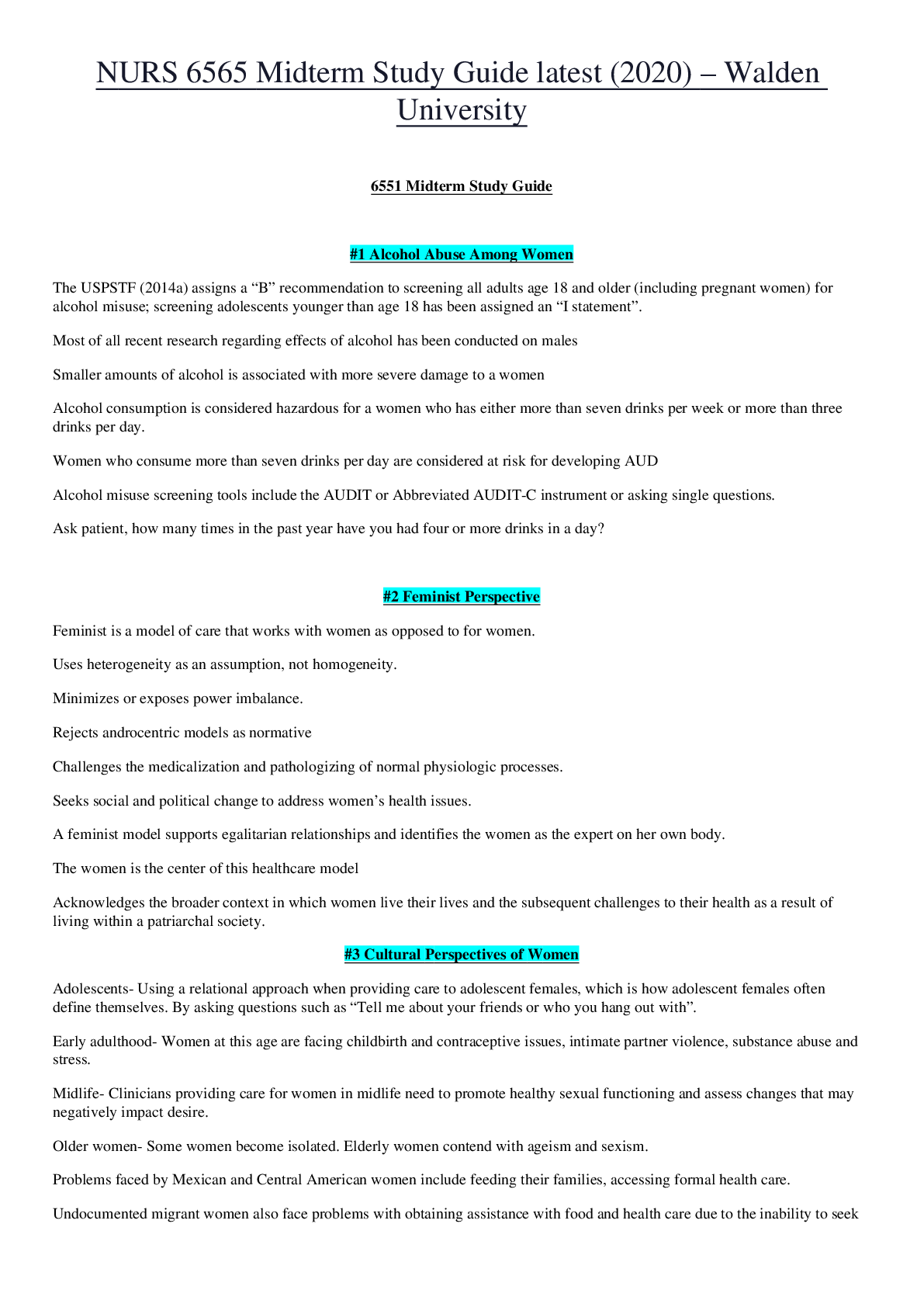
Reviews( 0 )
Document information
Connected school, study & course
About the document
Uploaded On
May 29, 2020
Number of pages
119
Written in
Additional information
This document has been written for:
Uploaded
May 29, 2020
Downloads
0
Views
63

